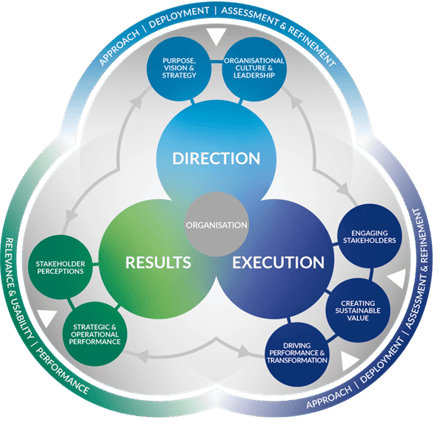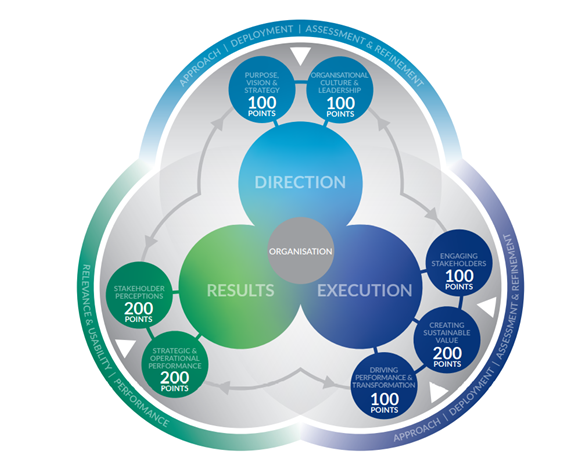So you want to be excellent? Will the EFQM Excellence model help you achieve that? Given its name it really should. In this article I explore the 2020 EFQM Excellence Model and how useful it really is for organisations striving for business improvement and more effective quality management.
This article covers:
- What is the EFQM Excellence Model?
- RADAR
- EFQM Recognition for Excellence
- Is the EFQM Excellence Model actually Useful?
What is the EFQM Excellence Model?
Originally launched in 1992 by the European Foundation for Quality Management (EFQM), the EFQM Excellence Model was created to help organisations - regardless of size or sector - to develop and implement their strategies to increase the competitiveness of European organisations.
Since then the model has adapted and evolved over time to reflect changes in the global market place. The 2020 model is the latest EFQM Excellence Model and it has changed fundamentally since the previous (2013) one.
The latest model has shifted from being a simple assessment tool to one that offers 'a framework and methodology to help with the changes, transformation, and disruption that individuals and organisations face every day'.
The 2020 EFQM Model (structured very differently from the 2013 one) is based on the asking of three questions: Why? How? and What?
- Why does this organisation exist? What Purpose does it fulfil? Why this particular Strategy? (Direction)
- How does it intend to deliver on its Purpose and its Strategy? (Execution)
- What has it actually achieved to date? What does it intend to achieve tomorrow? (Results).
This drives the three key sections of the new framework: Direction, Execution and Results.

Each one of these is supported by two or three criteria - there are seven in total - each one of which is supported by a series of guiding principles. (The positioning statements for each criterion are set out below, not the full guiding principles.)
Direction
- Criterion 1: Purpose, Vision and Strategy - An outstanding organisation is defined by a Purpose that
inspires, a Vision that is aspirational and a Strategy that delivers. - Criterion 2: Organisational Culture and Leadership
- Organisational Culture is the specific collection of values & norms that are shared by people and groups within an organisation that influence, over time, the way they behave with each other and with Key Stakeholders outside the organisation.
-
- Organisational leadership relates to the organisation as a whole rather than any individual or team that provides direction from the top. It is about the organisation acting as a leader within its ecosystem, recognised by others as a role model, rather than from the traditional perspective of a top team managing the organisation.
Execution
- Criterion 3: Engaging Stakeholders - Having decided which Stakeholders are the most important to the organisation, i.e. its Key Stakeholders, and independent of the specific groups identified, it is highly
likely that there is a degree of similarity in applying the following principles when engaging with Key Stakeholders. - Criterion 4: Creating Sustainable Value - An outstanding organisation recognises that Creating Sustainable Value is vital for its long-term success and financial strength.
- Criterion 5: Driving Performance & Transformation - Now and in the future, an organisation needs to be able to
meet the following two important requirements at the same time to become and remain successful.
Results
- Criterion 6: Stakeholder Perceptions - This criterion concentrates on results based on feedback from Key Stakeholders about their personal experiences of dealing with the organisation – their perceptions.
- Criterion 7: Strategic & Operational Performance - This criterion concentrates on results linked to the organisation’s performance in terms of:
- The ability to fulfil its Purpose, deliver the Strategy and Create Sustainable Value.
- Its fitness for the future.
The 2020 EFQM Model aims to give organisations the opportunity to take a holistic perspective and appreciate that each organisation is a complex but, at the same time, organised system.
To download your free short version of the EFQM Model in English please click here: EFQM Model - Short Version
RADAR
RADAR is the EFQM's diagnostic tool. The name RADAR come from it's belief that an organisation needs to:- Determine the Results it is aiming to achieve as part of its strategy
- Have in place a number of Approaches that will deliver the required results, both now and in the future
- Deploy these approaches appropriately
- Assess and Refine the deployed approaches to learn and improve
Organisations applying for EFQM recognition are scored out of 1,000 points, which are divided across the seven criteria as shown in the image below.
EFQM Recognition for Excellence
The EFQM's system of recognition aims to shows how well an organisation is performing against the EFQM Model. Organisations can achieve different levels of recognition:
- Validated by EFQM
- Qualified by EFQM
- Recognised by EFQM, 3-7 stars
- EFQM Global Award
The EFQM recognition process is carried out by independent EFQM Assessors. They review performance using the Model and offer tailored feedback throughout the process.
Self Assessment
Three scoring matrices can also be used by organisations wanting to self-assess against the EFQM Model:
- EFQM "Foundation Level" Questionnaire - A “light touch” assessment, using a simple questionnaire, to help “curious/less mature” organisations identify their current position and determine potential improvement opportunities.
- Business Matrix Assessment Tool - This provides a more rigorous assessment referenced against all Criterion of the EFQM Model and provides a score on the RADAR elements. Using this tool, organisations can generate a more detailed understanding of their performance.
- Business Matrix Advanced Assessment Tool - This provides a complete assessment against all Criterion-parts of the EFQM Model, the associated Guidance Points and score on the full RADAR Attributes. Using this tool, organisations can generate a detailed baseline on their performance and identify where they currently excel and where there are opportunities for improvement.
Is the EFQM Excellence Model actually Useful?
Yes I think we can safely say that the 2020 EFQM Excellence Model is definitely useful. As Nenad Savic says in his thoughtful article on the subject, 'The logic of new EFQM model (Why-Direction, How-Execution, What-Results) is so fundamental and it is so obvious, that (it) addresses not only how to be excellent but - what is even more important - how to be radically different by understanding and reacting to all the relevant megatrends and other impulses in the environment.'
The EFQM itself recognised its 2013 model as purely an assessment tool and have made fundamental changes to the 2020 model, developing a framework and methodology to help organisations deal with the global shifts that continually reshape the world we live in. (The Covid global pandemic being a prime example.)
Using the EFQM Excellence Model will help your organisation to:
- Define it's purpose
- Create it's culture
- Forge strong leaders
- Foster agile practices
- Address unique organisational challenges
- Forecast the future
However, it shouldn't be thought of as a one-stop-shop for business improvement. To support your implementation of the EFQM Excellence Model you will definitely need a management system that is structured around Continuous Improvement.
Also, just like anything in the improvement space (and in life in general) what you get out is entirely dependent on what you put in. Continuous Improvement requires hard work and commitment to:
- Create a culture of Continuous Improvement
- Capture everyone's ideas for improvement - as Panasonic founder, Konosuke Matsushita once said, "continued existence depends on the mobilisation of every ounce of intelligence"
- Implement prioritised improvement plans as business as usual
- Excellent and ongoing communication
Adopting the EFQM Excellence Model will certainly help you with this, but of course the hard work still has to be done by you.
Related Articles:
What is Continuous Improvement? A Simple Guide
How do I create a culture of Continuous Improvement?
How to Build a Continuous Improvement Roadmap: a Practical Guide
10 Business Improvement Techniques Successful Businesses Share
Related White Papers:
The Complete Guide to Continuous Improvement in Business
Written by Emma Harris
Emma was Operations Director for Triaster for nearly 20 years, during which time as well as learning and perfecting her BPM and process improvement skills, she honed her inbound marketing expertise. She now runs D2e - Designed to engage - which designs and develops bespoke, engaging, HubSpot CMS websites, that help your entire company to grow and scale. She is delighted to still be delivering Triaster's marketing, whilst also helping other companies turn their websites into their hardest working asset.


